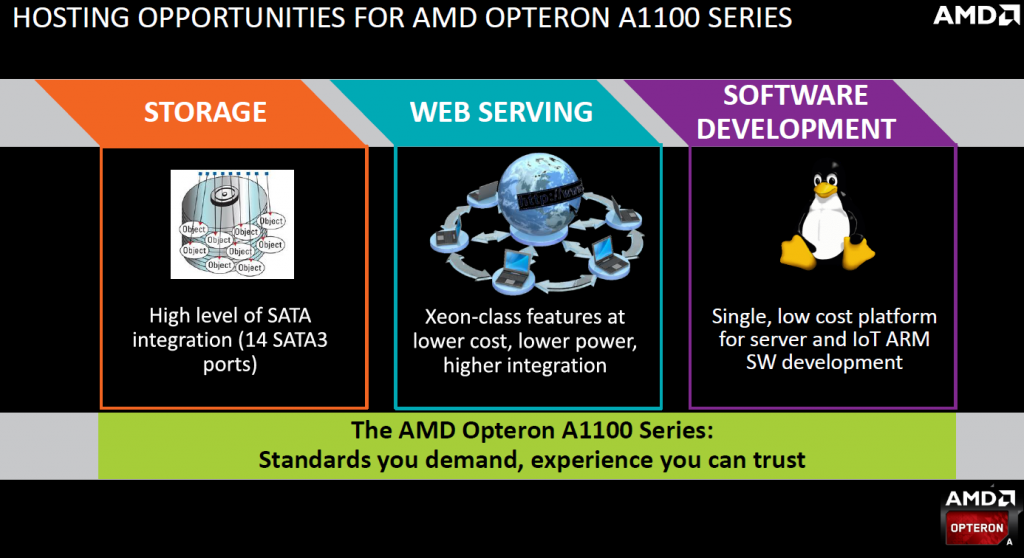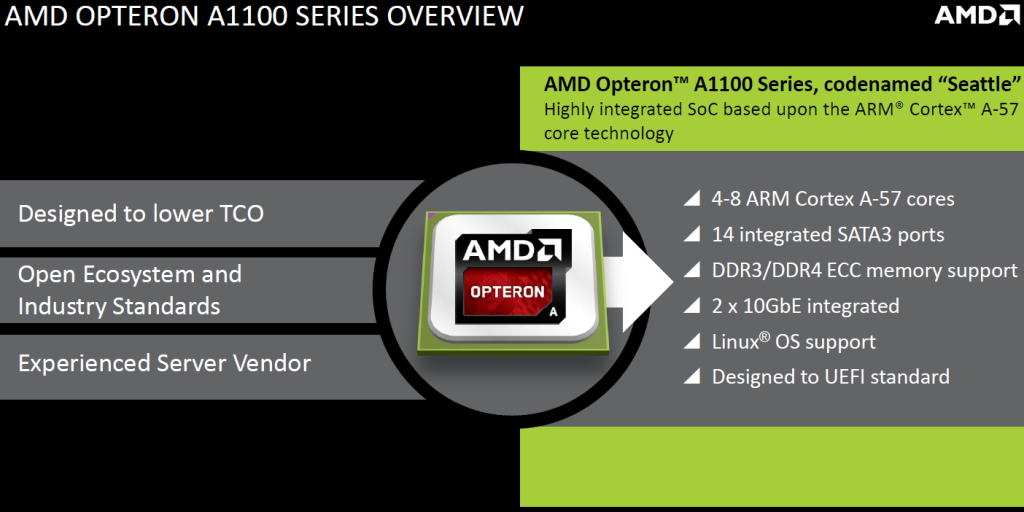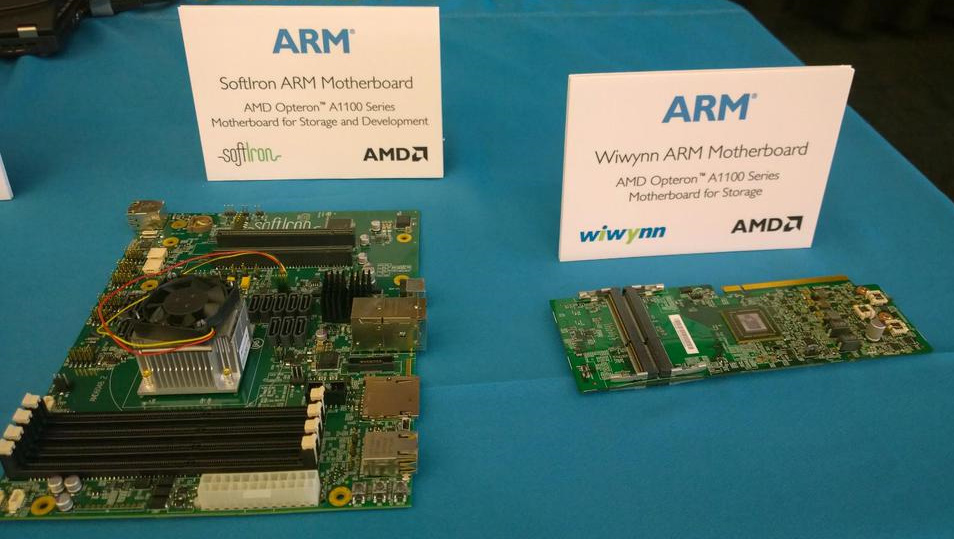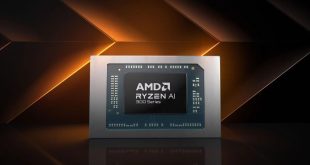Advanced Micro Devices this week confirmed that it plans to start volume shipments of its first 64-bit ARMv8-A-based Opteron microprocessor code-named “Seattle” in the second half of this year, which represents a massive one year postponement. The reasons of the delay are unclear, it is also unknown whether AMD has lost any revenue opportunities because of it.
“We continue to sample Seattle and customers are continuing to develop both systems and software,” said Lisa Su, chief executive officer of AMD, in the company’s quarterly conference call with investors and financial analysts. “Relative to the production ramp for volume shipments, I think we will see that in the second half of this year.”
The AMD Opteron A1100 system-on-chip code-named “Seattle” is AMD’s first server-class solution based on the 64-bit ARMv8-A architecture. The SoC packs up to eight ARM Cortex-A57 general-purpose cores with up to 4MB shared L2 cache and 8MB shared L3 cache as well as numerous special-purpose engines for better power efficiency and reduced CPU loading, including server caliber encryption, and compression. The central processing unit sports server-class dual-channel memory controller that supports up to 128GB of DDR3 or DDR4 ECC memory in un-buffered DIMMs, registered DIMMs or SODIMMs. In addition, the AMD Opteron A1100 processor has extensive integrated I/O, including eight PCI Express 3.0 lanes, two 10Gb/s Ethernet ports, eight Serial ATA-3.0 ports as well as now-obsolete Freedom fabric. The chips are manufacturing using an unknown 28nm process technology.

Originally, AMD planned to ship its Opteron A1100 “Seattle” in the second half of 2014. However, in mid-2014 the company only started to sell “Seattle” software development kits to interested parties. So far only MicroStar International (MSI), SoftIron and Wiwynn (a division of Wistron) expressed interest in making servers based on the Opteron A1100. Still the chip is probably evaluated by all owners of hyperscale cloud datacenters, such as AWS, Google, Facebook and other. Those, who plan to deploy the AMD Opteron A1100, need to develop appropriate software first because the vast majority of server apps today were designed to run on microprocessors featuring x86 architecture.
Since software development typically takes a long time, demand for AMD’s “Seattle” processor today may be negligible, which is why the company does not initiate high-volume manufacturing. Nevertheless, while “Seattle” may not be needed by the market today, the big question is whether it will face massive demand in the second half of the year from the server makers given availability of competing solutions in the 2H 2015.
Cavium Networks is currently sampling its ThunderX server-class system-on-chip solutions with 24 to 48 custom ARMv8-A cores; quad-channel DDR3/DDR4 memory controller (up to 76.8GB/s bandwidth at 1866MHz) that supports up to 1TB of memory; integrated hardware accelerators for security, storage, networking and virtualization applications; feature-rich I/Os capabilities (10/40GbE ports, SATA ports, PCI Express) and even SMP [symmetrical multiprocessing] support. At least on paper, Cavium’s ThunderX looks very competitive. In fact, Cray, Lenovo and Hewlett-Packard have shown interest in the ThunderX. Moreover, Cray announced a plan to deliver Cray Cluster Solutions for the high-performance computing market using ThunderX. Cavium’s ThunderX will be available in high-volume in late 2015.
Discuss on our Facebook page, HERE.
KitGuru Says: It looks like the AMD Opteron A1100 “Seattle” will be mostly a software development vehicle that will hardly be deployed widely. It is highly likely that successors of the “Seattle” will not only feature more cores, but also a lot of special-purpose hardware (i.e., accelerators) and custom logic for particular customers.
 KitGuru KitGuru.net – Tech News | Hardware News | Hardware Reviews | IOS | Mobile | Gaming | Graphics Cards
KitGuru KitGuru.net – Tech News | Hardware News | Hardware Reviews | IOS | Mobile | Gaming | Graphics Cards






Reading AMD news is as cheerfuller as walking in a graveyard.
Seriously, at least at the start of the year there was some hope of releases early 1st quarter…now its just dread. I honestly wonder if they are even producing anything at the moment.
Tip for AMD survival:
Fire at least 50% management staffs from the company.Hire more skilled engineers………
AMD should be concentrating on their x86 Opteron development rather than dabble away with ARM alternatives that seems to be going nowhere. For example, AMD’s low power Opteron X2150: http://www.amd.com/en-us/products/server/opteron-x/x2150#specs (which uses Jaguar cores: http://www.anandtech.com/show/6992/amd-opteron-x1150-x2150-kyoto-kabini-heads-to-servers ) has been used in HP Moonshot: http://www8.hp.com/us/en/products/solutions/product-detail.html?oid=6636567#!tab=specs This Seattle chip project looks to be a waste of resources, time and money…
Due to ARM’s infancy in servers, most of them end up either as storage server functions (example: http://www.marvell.com/company/news/pressDetail.do?releaseID=3576 ) or web caching functions (as in HP Moonshot’s Proliant m400: http://www8.hp.com/us/en/products/proliant-servers/product-detail.html?oid=7398907#!tab=specs ), just like those prototype boards using AMD’s Opteron A1100 from SoftIron and Wiwynn (as shown above in this article, for storage functions). Currently the market for micro servers is a tiny niche: http://www.fool.com/investing/general/2015/03/17/facebook-incs-partnership-with-intel-corporation-b.aspx quotes…
“IDC believes microservers could account for 10% of the global server market by 2016, up from just 0.2% in 2011. Today, Intel’s Xeon E3 and Atom C2000 SoCs are installed in many low-end microservers, but they only account for a tiny sliver of its data center business, which generated $14.4 billion in revenue last year.”
By the time AMD’s Opteron A1100 ever managed to appear in actual products, it will be facing not only Intel (Atom C2000 series, Xeon E3 series and Xeon D series: http://www.anandtech.com/show/9070/intel-xeon-d-launched-14nm-broadwell-soc-for-enterprise ) but also other ARM server chip competitors like Applied Micro (X-Gene), Cavium (ThunderX) and possibly HiSilicon (see: http://www.cnx-software.com/2015/02/16/hisilicon-d02-armv8-server-board/ )…
Well this would have been a decent product if released last autumn as it should have been.
It would still be decent as a devel platform because it’s a poweful ARM64 SOC and there really aren’t any good devel boards with ARM64.
I can also see it getting adopted for storage stuff that requires lots of DATA ( it has 10+ SATA connectors ) and a high bandwith connectiong ( 10 Gbit ). If you don’t also need much processing power this is good enough.